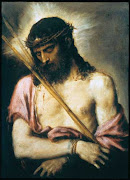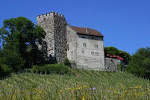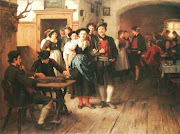
The great
Feast of the Sacred Heart of Jesus is of ancient origin.
Some - particularly Jansenists and particular types of Protestants - claim that this devotion is a novelty.
It is certainly not novel.
Indeed, the Fathers of the Church already had a devotion to the wounded heart of Jesus as can readily be seen from their writings.
However, by the time of the eleventh and twelfth centuries a special devotion to the Sacred Heart was being developed and cultivated. It was taken up particularly by
St Bruno and the
Carthusians.
The
Cistercians also were much devoted to the heart of Jesus, particularly
St Bernard himself.
St Gertrude the Great and
St Mechtilde were also great promoters of the devotion as also the learned the author of the "
Vitis mystica", thought to be
St Bonaventure.
From the thirteenth to the sixteenth centuries, the devotion was everywhere practised by individuals and by different religious congregations, such as the
Franciscans and the
Dominicans.
It was established as a devotion with prayers already formulated and special exercises, found in the writings of
Lanspergius (d. 1539) of the Carthusians of Cologne,
Louis of Blois (Blosius, 1566), a Benedictine and Abbot of Liessies in Hainaut,
John of Avila (d. 1569) and
St Francis de Sales, the latter belonging to the seventeenth century.
It was also the symbol (see inset above) of the
Grand Catholic and Royal Army of Catholic France against the diabolical forces of the French Revolution that sought to destroy all religion, truth, honesty, justice and true freedom in France.
 St Gertrude the Great, Visionary-Apostle of the Sacred Heart
St Gertrude the Great, Visionary-Apostle of the Sacred Heart
The image of the Sacred Heart of Jesus was everywhere in evidence, largely due to the Franciscan devotion to the
Five Wounds and to the habit formed by the
Jesuits of placing the image on their title-page of their books and the walls of their churches.
The Jesuits subsequently became the great defenders of the devotion to the Sacred Heart and were opposed by the mean-minded, narrow, puritanical but revolutionary
Jansenists who mockingly called the devotees of the Sacred Heart by the name of
Cordicoles or heart-worshippers.
Jansenists, like
Bishop Scipione de' Ricci of Pistoia-Prato in Tuscany, later openly embraced the principles of the French Revolution whilst those Catholics who fought against the Revolution frequently adopted the Sacred Heart as their symbol.
The heresiarch Jansenist, Bishop Scipione de' Ricci, the Bishop of Pistoia-Prato
Ricci worked in conjunction with Prince Kaunitz, the Freemasonic Chancellor of State (Prime Minister) of the Holy Roman Empire, who had consolidated himself in the government of the Empire under Empress Maria Theresa, and later under the liberal Modernist heterodox Catholic, Emperor Joseph II.
Joseph's younger brother, Grand Duke Peter Leopold of Tuscany, later himself Emperor for 2 years, was also a willing aider and abetter of Ricci's schemes.
Consider the disaster that it was for the Catholic Church, for European civilisation and for the whole world that the Christian Roman Emperor, he who had the most solemn duty to defend the Church and the Papacy and to defend and extend the bounds of Christendom, should have become, himself, a hypocrite, a liar, an heterodox deceiver and destroyer of the Church of Jesus Christ which he was pledged, upon a solemn oath, to defend and who derived all his power and privileges from that same duty.
It was the beginning of modern politics - power without responsibility, privilege without duty, desiring the the goods of this world whilst depriving others of them.
In short, the very Emperor himself had become the servant of Satan and had paved the ideological way for the devilish totalitarianism that was to come 2 centuries later.
Ricci held a famous Synod at Pistoia in which, with the support of the Grand Duke, he tried to impose, experimentally, an early form of liberal Modernist Catholicism upon people and clergy in his diocese.
But - the people rose up, locked his Synod members in the Seminary and would not let them out until they had rescinded all the Modernist decrees, even taking off roof-tiles to get them to hurry the rescissions!
Few foresaw that the foolish experiments of the Jansenists and liberal Modernists would lead to them, the Empire and the Grand Duchy being altogether swept away by the tide of revolutionary hatred and violence.
Some Jansenists, after the Terror, returned to the Faith but by then the damage was done.
Ricci did not return until 1805, after he had seen the arrest of Pope Pius VII by Napoleon Bonaparte who compelled him to come to Paris and there to preside at the coronation of the destroyer of Christendom. It finally dawned on Ricci that his experiments had not had a good result.
 Heterodox Habsburg: HI&RH Grand Duke Peter Leopold of Tuscany was that rare thing, an heterodox Habsburg. He supported Ricci's ill-fated schemes and so prepared the way for his own family's later fall.
Heterodox Habsburg: HI&RH Grand Duke Peter Leopold of Tuscany was that rare thing, an heterodox Habsburg. He supported Ricci's ill-fated schemes and so prepared the way for his own family's later fall.
The faithless disloyalty of these Jansenists, Febronianists, Gallicanists and other liberal Catholics who had lapsed from the Faith, wrought appalling damage to Christendom and eventually led to the complete overthrow of Christendom.
Conversely, the Sacred Heart symbol became one of the great symbols of the defence of the Faith during the French revolutionary period and was used by the many Catholics who rose up against the usurping secularists and revolutionaries, not least in the Vendée region of Western France.
The enemies of the Sacred Heart of Jesus had become, wittingly or not, the prime tools of Satan. That is their legacy - fittingly so, since it is Satan who is primarily opposed to the love of God which is so much a part of the devotion to the Sacred Heart.
 St John Eudes, Apostle of the Sacred Heart of Jesus
St John Eudes, Apostle of the Sacred Heart of Jesus
St John Eudes (1602-1680) publicly and enthusiastically promoted the devotion and gave it an Office and established a feast for it. St John Eudes was also the apostle of the
Immaculate Heart of Mary.
On 31 August 1670, the first feast of the Sacred Heart was celebrated in the
Grand Seminary of Rennes in Brittany. Coutances followed suit on 20 October, a day with which the Eudist feast was from then on to be connected.
The feast soon spread to other dioceses, and the devotion was likewise adopted in various religious communities. It gradually came into contact with the devotion begun at
Paray-le-monial resulting in a fusion of the two.
 Our Lord shows His Sacred Heart to St Margaret Mary Alacoque
Our Lord shows His Sacred Heart to St Margaret Mary Alacoque
Eventually the devotion was hallowed by private revelation with the now famous revelations to
St Margaret Mary Alacoque in the Visitation convent in
Paray-le-monial.
Thereafter the devotion was taken by her confessor and spiritual director,
St Claude de la Colombiere SJ, to England where, as chaplain to the English Queen,
Mary of Modena, he was able to promote the devotion.
 St Claude de la Colombiere SJ, confessor of both St Margaret Mary Alacoque and HRH Queen Mary of England, wife of King James II and VII. He was a great promoter of the Sacred Heart devotion.
St Claude de la Colombiere SJ, confessor of both St Margaret Mary Alacoque and HRH Queen Mary of England, wife of King James II and VII. He was a great promoter of the Sacred Heart devotion.
In 1676 he had been sent to England as preacher to Mary of Modena, Duchess of York, afterwards Queen and wife to
King James II and VII, the true Stuart monarch of England, Scotland, Ireland and France.
It is fitting that Mary came from Modena which is not far north of that later centre of Jansenism, Pistoia.
St Claude lived the life of a Religious even in the Court of St. James and was as active a missionary in England as he had been in France. Although encountering many difficulties, he was able to guide Saint Margaret Mary by letter.
 HRH Princess Mary of Modena-Este, Duchess of York as wife to the future King James II and VII and thus, later, Queen of England. Her confessor was St Claude de la Colombiere SJ whom she helped to spread the devotion to the Sacred Heart of Jesus in England
HRH Princess Mary of Modena-Este, Duchess of York as wife to the future King James II and VII and thus, later, Queen of England. Her confessor was St Claude de la Colombiere SJ whom she helped to spread the devotion to the Sacred Heart of Jesus in England
Now the Feast is a great one and has an Octave. An external solemnity is also permitted to be celebrated on the Sunday during the Octave.
St Longinus,
the Roman soldier who opened the side of our Lord with a spear but later converted to Christianity - his statue is in St Peter's Basilica
"Unus militum lancea latus ejus aperuit, et continuo exivit sanguis et aqua".
"One of the soldiers with a spear opened His side and immediately there came out blood and water".
[John, 19:34. Communio, Feast of the Sacred Heart]








.jpg)

















_-002.jpg/220px-Circle_of_Anton_Raphael_Mengs,_Henry_Benedict_Maria_Clement_Stuart,_Cardinal_York_(ca_1750)_-002.jpg)

